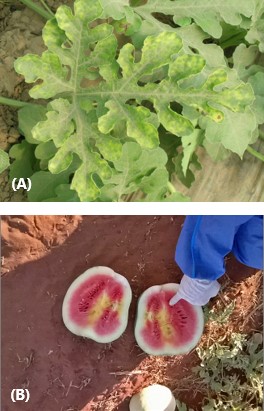
Cucumber green mottle mosaic virus
| Primefact number | Edition | Published | Author |
|---|---|---|---|
| 1723 | First | Mar 2020 | Plant Biosecurity and Product Integrity |

Cucumber green mottle mosaic virus is a serious threat to NSW cucurbit industries.
Webinar
A webinar was held on Thursday 25 June to give an update on Cucumber Green Mottle Mosaic Virus. Our plant biosecurity experts provided information about the situation in NSW, host crops and weeds, symptoms and what to look for, and management options. The webinar was recorded and can be viewed here.
Description
Cucumber green mottle mosaic virus (CGMMV) is a plant virus of the genus Tobamovirus. There are at least five strains of the virus affecting fruit and vegetables of the plant family Cucurbitaceae, including watermelon, rockmelon, honeydew, cucumber and pumpkin.
Symptoms of virus affected plants vary between species and strain of virus, however mosaic mottling of leaves is the symptom most frequently observed. Other symptoms include vein-clearing, vein-banding, leaf distortion and internal discolouration of fruit and rotting.
In watermelon, symptoms typically include mosaic-like mottling on the mature leaves (Figure 1A) and affected plants may appear bleached and stunted with lesions on the stem and peduncle. Symptoms may also appear in young plants then disappear as the plant matures making detection difficult.
Fruit symptoms may include yellowing of internal flesh (Figure 1B) and sponge-like texture not suitable for market.
In rockmelon and honeydew, the virus causes mosaic and green vein-banding on mature leaves and affected plants appear stunted. Infected melons show mottled symptoms.
Host range
In addition to watermelon and melon, CGMMV also infects cucumber, squash, gherkin, sinquar, pumpkin, bitter gourd and bottle gourd. Weeds such as fat hen, black nightshade, amaranthus and purslane can also act as green bridge hosts for CGMMV.
Spread
Upon infection, CGMMV multiplies and spreads within the plants systemically through sap. Virus particles remain viable in seed, infected plant material and in soil. In soil, the virus can persist for many years.
CGMMV is highly transmissible and is easily mechanically transmitted by direct plant to plant contact, contaminated tools, hands, clothing, machinery and planting trays. CGMMV can also be transmitted in water and by bees through infected pollen.
Infected seeds are the main source of long-distance spread.
Lifecycle
Like all other plant viruses, CGMMV requires a living plant host for multiplication and spread.
Damage
CGMMV infection causes structural changes in infected tissues leading to mottling of leaves and fruits and stunting of plants. Infected fruits are generally unmarketable. CGMMV infected plants cannot be cured.
Distribution
CGMMV is known to occur in North America, Europe, Asia and the Middle East.
In Australia, CGMMV was first reported in field crops in the Northern Territory in 2014. Outbreaks have subsequently been reported from Western Australia, Queensland and in NSW.
Actions to minimise risk
Put in place biosecurity best practice actions to prevent entry, establishment and spread of pests and diseases on or from your property:
- practise “Come clean, Go clean”
- ensure all staff and visitors are instructed in and adhere to your business management hygiene requirements
- source seed and propagation material of a known high health status from reputable suppliers. Don't share seed or seedlings with other growers
- request certification that your seed has been tested free of CGMMV
- monitor your crop regularly
- keep records
- report suspect symptoms
- isolate and destroy infected plants or areas with suspect symptoms to prevent further spread

